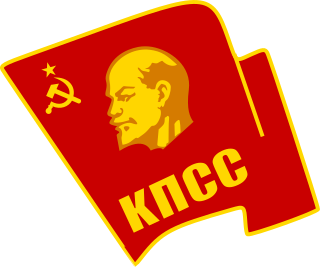
The Communist Party of the Soviet Union (CPSU), at some points known as the Russian Communist Party (Bolsheviks) and All-Union Communist Party (Bolsheviks), sometimes referred to as the Soviet Communist Party (SCP), and formerly known as the Bolshevik Party, was the founding and ruling political party of the Soviet Union. The CPSU was the sole governing party of the Soviet Union until 1990 when the Congress of People's Deputies modified Article 6 of the 1977 Soviet Constitution, which had previously granted the CPSU a monopoly over the political system. The party's main ideology was Marxism-Leninism.
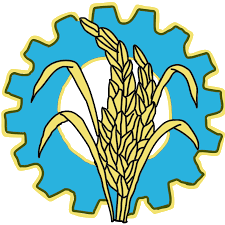
The Burma Socialist Programme Party (BSPP) was Burma's ruling party from 1962 to 1988 and sole legal party from 1964 to 1988. Party chairman Ne Win overthrew the country's democratically elected government in a coup d'état on 2 March 1962. For the next 26 years, the BSPP governed Burma under a totalitarian military dictatorship, until mass protests in 1988 pressured party officials to adopt a multi-party system.
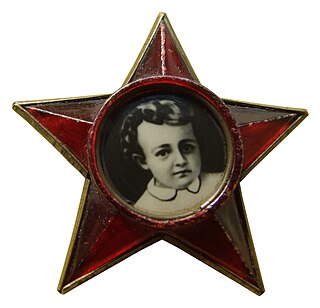
Little Octobrists is the name of a youth organization for children between 7 and 9 years of age in the Soviet Union. After the age of nine, in the 3rd grade, Little Octobrists would typically join the Young Pioneer organization.

The Ernst Thälmann Pioneer Organisation, consisting of the Young Pioneers and the Thälmann Pioneers, was a youth organisation of schoolchildren aged 6 to 13 in East Germany. They were named after Ernst Thälmann, the former leader of the Communist Party of Germany, who was executed at the Buchenwald concentration camp.
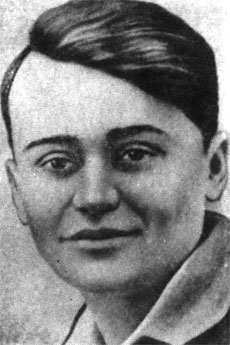
Oleg Vasilyevich Koshevoy was a Soviet partisan and one of the founders of the clandestine organization Young Guard, which fought the Nazi forces in Krasnodon during World War II between 1941 and 1945.

There are various controversies and conflicts that involve the Scouting movement. Scouting has sometimes become entangled in social controversies such as in nationalist resistance movements in India. Scouting was introduced to Africa by British officials as an instrument of colonial authority but became a subversive challenge to the legitimacy of British imperialism as Scouting fostered solidarity amongst African Scouts. There are also controversies and challenges within the Scout Movement itself such as current efforts to turn Scouts Canada into a democratic organization.

The Socialist Patriotic Youth League is a North Korean youth organization. It is the main youth organization in North Korea. Directly under the party Central Committee, it is the only mass organization expressly mentioned in the charter of the Workers' Party of Korea. Youth under 15 may join the Young Pioneer Corps, itself a part of the larger Korean Children's Union. The organization, modeled after the Komsomol in the former Soviet Union, includes all North Koreans without party membership between the ages of 15 and 30, although married women who opt to become housewives are transferred to the Socialist Women's Union. Officially, the guiding ideology of the organization is Kimilsungism–Kimjongilism.
Young Pioneers may refer to:
In Russia, efforts to build communism began after Tsar Nicholas II lost his power during the February Revolution, which started in 1917, and ended with the dissolution of the USSR in 1991. The Provisional Government was established under the liberal and social-democratic government; however, the Bolsheviks refused to accept the government and revolted in October 1917, taking control of Russia. Vladimir Lenin, their leader, rose to power and governed between 1917 and 1924.

The Korean Children's Union (KCU) is the precursor to the Socialist Patriotic Youth League of North Korea contributing to North Korean youth movement and pioneer movement. It is for children aged six to fifteen and is a political organisation linked to the Workers' Party of Korea. Its uniformed branch is known as the Young Pioneer Corps, which admits children and pre-teens ages nine to 15. The organization operates chapters in elementary and secondary schools nationwide. It teaches children about Juche, and other ideologies behind the North Korean system. Youth above the age of 15 may join the Socialist Patriotic Youth League.

Pionýr, officially Pioneer Organization of the Socialist Youth Union, was a youth Marxist-Leninist organization in communist Czechoslovakia that was a subdivision of the Socialist Youth Union. Although the organisation proclaimed to be voluntary, every child was expected to join from the age of six.

The Komsomol of Ukraine, officially the Leninist Communist League of Youth of Ukraine, was a youth organization in the Ukrainian Soviet Socialist Republic under the Communist Party of Ukraine, a component part of the All-Union Lenin's Communist League of Youth (Komsomol). It was first established in 1919 as the youth wing of the Communist Party (Bolsheviks) of Ukraine and later revived in 1997 as the youth wing of the modern Communist Party of Ukraine; that party was banned in 2015 and terminated in 2022.

The All-Union Leninist Young Communist League, usually known as Komsomol, was a political youth organization in the Soviet Union. It is sometimes described as the youth division of the Communist Party of the Soviet Union (CPSU), although it was officially independent and referred to as "the helper and the reserve of the CPSU".

The World Federation of Democratic Youth (WFDY) is an international youth organization, and has historically characterized itself as left-wing and anti-imperialist. WFDY was founded in London, United Kingdom in 1945 as a broad international youth movement, organized in the context of the end of World War II with the aim of uniting youth from the Allies behind an anti-fascist platform that was broadly pro-peace, anti-nuclear war, expressing friendship between youth of the capitalist and socialist nations. The WFDY Headquarters are in Budapest, Hungary. The main event of WFDY is the World Festival of Youth and Students. The last festival was held in Sochi, Russia, in October 2017. It was one of the first organizations granted general consultative status with the United Nations Economic and Social Council.
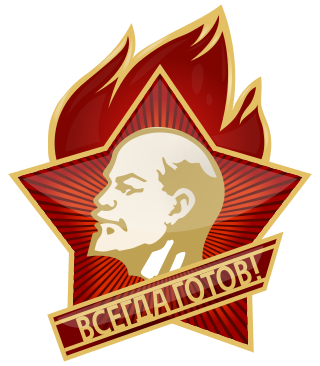
The Vladimir Lenin All-Union Pioneer Organization, abbreviated as the Young Pioneers, was a compulsory youth organization of the Soviet Union for children and adolescents ages 9–14 that existed between 1922 and 1991.
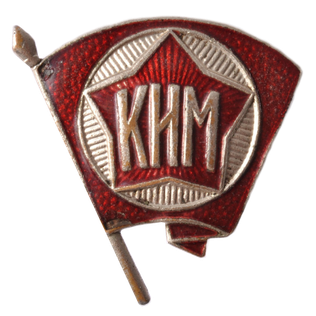
The Young Communist International was the parallel international youth organization affiliated with the Communist International (Comintern).
Communist symbolism represents a variety of themes, including revolution, the proletariat, the peasantry, agriculture, or international solidarity. The red flag, the hammer and sickle and the red star or variations thereof are some of the symbols adopted by communist movements, governments, and parties worldwide.
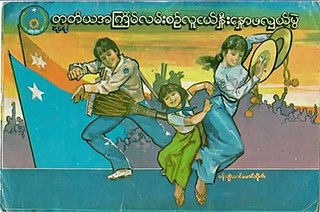
Lan-sin Lu-nge Aphwe was a youth organization in Socialist Republic of the Union of Burma for high school and university students to learn useful skills and about the socialist politics of the Burma Socialist Programme Party. It consisted of three main branches: Tei-za Lu-nge, Shei-hsaung Lu-nge and Lan-sin Lu-nge. Teiza Lu-nge wore blue scarf and Shei-hsaung Lu-nge wore the Red scarf.
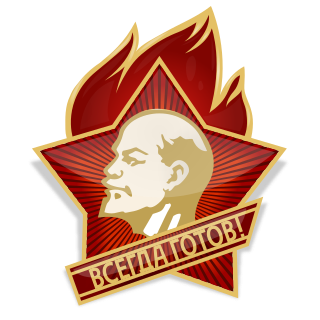
Always prepared is the motto of the Pioneer movement, adopted by most of the Pioneer organizations in socialist countries. The motto is a common feature on the organizations' badges. The motto echoes the Scout motto, "Be Prepared." After the end of the Russian Civil War, the Scout organization of the former Tsarist Russia was replaced with the Young Pioneers. The modification of the Scout's motto was suggested by the leaders of Russian Scouts who supported the Red Army and the Komsomol. The Scout motto, in use since 1907, meant that Scouts needed to be physically and mentally ready. The "always ready" of the young pioneers is mostly related to socialism, peace and country building.

The Leninist Young Communist League of Lithuania or Lithuanian Komsomol was the Lithuanian branch of the Soviet Komsomol that served as the youth organ of the Communist Party of Lithuania. The organization was for youth ages 14 to 28. Younger children were organized into Pioneers and Little Octobrists. Since Komsomol was the only legal youth organization in the Soviet Union, it had significant impact and influence on the youth.






















